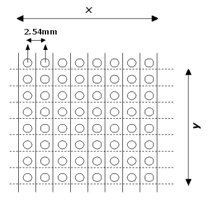
| Home | ||
| Tactile Displays | ||
| ER Fluids | ||
| Actuators | ||
| News | ||
| Contact Us | ||
Smart Technology will be the first manufacturer to use ER fluids in cost effective tactile displays suitable for mass
production. The developed technology uses unique processes and off the shelf materials and know how to achieve a previously
unattainable retail price. Current employed technology, based on Piezo actuators, works with voltages of a couple of hundred
volts and Smart ER tactile valve technology uses comparable operating voltages for safety reasons.
 |
All Smart Technology tactile displays employ the same technology based on ER fluid. Each display will consist of a number of ER valves that can individually isolate a single pin; where each pin represents a dot. There are almost no restrictions on the total number of dots per display, however generally the more dots there are per display the cheaper the display gets per dot (relative). Dot to dot spacing is 2.54mm (0.1 inch) in an evenly spaced grid / matrix. The same spacing is used for displaying Braille and graphics. The resulting cell spacing of 2.54mm between cell dots, 5.08mm between cells, and 7.62mm between words is slightly different than most Braille users are used to but proved more than acceptable in extensive user trials. Dot height and shape have been designed the same as existing devices. |
In existing Piezo Braille devices all dots are raised at the same time, however on new Smart tactile units dots are raised on a line by line basis. This method was chosen to reduce overall cost, which was an important design criteria from the outset. This refresh strategy and the use of Electro-Rheological (ER) fluid will make this device more affordable than those previously available.
One important feature of the new display is the integration of touch sensitive feedback using a specially developed "finger responsive" coating on top of the tactile area. This touch screen coating is used to give the user interactive access to programs like Internet Explorer and is resilient to normal wear and tear.
Smart tactile units will operate under Microsoft Windows and a driver API (Application
Programmable Interface) has been publicly released to support third party application development.
The units will also work with existing screen reader software and suitable drivers have been developed for
popular programs.
The units will interface with the computer via Universal Serial Bus (USB).
In the near future support for other operating systems (for example Windows CE and Linux) and other computer interfaces
(for example Bluetooth) will be supported.
<< Previous Page: Tactile Products For more information on Smart's Tactile displays click here